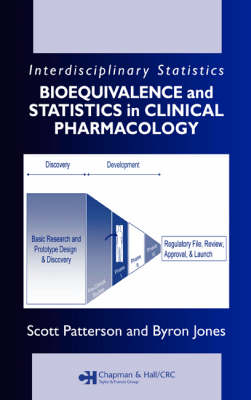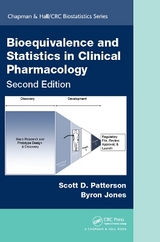
Bioequivalence and Statistics in Clinical Pharmacology
Chapman & Hall/CRC (Verlag)
978-1-58488-530-6 (ISBN)
- Titel erscheint in neuer Auflage
- Artikel merken
Maintaining a practical perspective, Bioequivalence and Statistics in Clinical Pharmacology explores statistics used in day-to-day clinical pharmacology work. The book covers the methods needed to design, analyze, and interpret bioequivalence trials; explores when, how, and why these studies are performed as part of drug development; and demonstrates the proposed methods using real world examples.
Drawing on knowledge gained directly from working in the pharmaceutical industry, the authors set the stage by describing the general role of statistics. Once the foundation of clinical pharmacology drug development, regulatory applications, and the design and analysis of bioequivalence trials are established, they move on to related topics in clinical pharmacology involving the use of cross-over designs. These include, but are not limited to, safety studies in Phase I, dose-response trials, drug interaction trials, food-effect and combination trials, QTc and other pharmacodynamic equivalence trials, and dose-proportionality trials. Purposefully designed to be instantly applicable, the book provides examples of SAS code so that the analysis described can be immediately implemented. The authors have made extensive use of the proc mixed procedures available in SAS.
Each chapter includes a vignette based on co-author Scott Patterson's experience in the clinical pharmacology work place and all the data sets are taken from real trials. The authors delineate practical utility and objectives, provide real-world examples of the topic under discussion, and include statistical theory and applications. Technical theory, where extensive, is included in technical appendices at the end of the chapter. Each topic contains worked examples that illustrate the applications of the statistical techniques and their interpretation. The authors also develop statistical tools useful for other topics of clinical pharmacology - namely general safety testing, testing for proarrythmic potential, population pharmacokinetics, and dose-selection.
DRUG DEVELOPMENT AND CLINICAL PHARMACOLOGY
Aims of This Book
Drug Development
Clinical Pharmacology
Statistics in Clinical Pharmacology
Structure of the Book
HISTORY AND REGULATION OF BIOEQUIVALENCE
When and How BE Studies Are Performed
Why Are BE Studies Performed?
Deciding When Formulations Are Bioequivalent
Potential Issues with TOST Bioequivalence
Current International Regulation
TESTING FOR AVERAGE BIOEQUIVALENCE
Background
Linear Model for 2 x 2 Data
Applying the TOST Procedure
Carry-over, Sequence, and Interaction Effects
Checking Assumptions Made about the Linear Model
Power and Sample Size for ABE in the 2 x 2 Design
Example Where Test and Reference Are Not ABE
Nonparametric Analysis
Some Practical Issues
BE STUDIES WITH MORE THAN TWO PERIODS
Background
Three-period Designs
Within-subject Variability
Robust Analyses for Three Period Designs
Four-Period Designs
Designs with More than Two Treatments
Nonparametric Analyses of Tmax
Technical Appendix: Efficiency
Tables of Data
DEALING WITH UNEXPECTED BE CHALLENGES
Restricted Maximum Likelihood Modelling
Failing BE and the DER Assessment
Simulation
Data-Based Simulation
Carry-Over
Optional Designs
Determining Trial Size
What Outliers are and How to Handle Their Data
Bayesian BE Assessment
Technical Appendix
THE FUTURE AND RECENT PAST OF BE TESTING
Brief History
Individual and Population BE
Scaled Average BE
CLINICAL PHARMACOLOGY SAFETY STUDIES
Background
First-time-in-humans
Sub-chronic Dosing Studies
Food-Effect Assessment and DDIs
Dose-Proportionality
Technical Appendix
QTC
Background
Modelling of QTc Data
Interpreting the QTc Modelling Findings
Design of a Thorough QTc Study in the Future
Technical Appendix
CLINICAL PHARMACOLOGY EFFICACY STUDIES
Background
Sub-chronic Dosing
Phase IIa and the Proof of Concept
Methodology Studies
POPULATION PHARMACOKINETICS
Population and Pharmacokinetics
Absolute and Relative Bioavailability
Age and Gender Pharmacokinetic Studies
Ethnicity
Liver Disease
Kidney Disease
Technical Appendix
Epilogue
Bibliography
Index
| Erscheint lt. Verlag | 10.11.2005 |
|---|---|
| Reihe/Serie | Chapman & Hall/CRC Biostatistics Series |
| Zusatzinfo | 124 Tables, black and white; 56 Illustrations, black and white |
| Sprache | englisch |
| Maße | 156 x 235 mm |
| Gewicht | 703 g |
| Themenwelt | Medizin / Pharmazie ► Medizinische Fachgebiete ► Pharmakologie / Pharmakotherapie |
| Technik | |
| ISBN-10 | 1-58488-530-0 / 1584885300 |
| ISBN-13 | 978-1-58488-530-6 / 9781584885306 |
| Zustand | Neuware |
| Haben Sie eine Frage zum Produkt? |
aus dem Bereich



